Meta-Analysis of the Performance of Pervious Concrete with Cement and Aggregate Replacements
Abstract
:1. Introduction
2. Review Methodology
3. Statistical Analysis
- Calculate the pooled standard deviation (Sp), also known as pooled d, using Equation (1).
- 2.
- Calculate the Effect size (E) following Equation (2).
- 3.
- Find the Variance (ð) using Equation (3).
- 4.
- Determine the value of corrected J by multiplying Equations (2) and (3) to obtain the modified Effect sizes and Variance, respectively, as per Equation (4).
- 5.
- The value of the modified Variance (₰) is inversed and multiplied by the modified Effect sizes (€) to obtain the fixed pooled d using Equation (5).
- 6.
- The fixed effect (F.E.) is then calculated at the upper and lower 95% confidence interval, as per Equation (6).
4. Geographical Distribution and Trend of Publications
5. Results and Discussion
5.1. Evaluated Properties of Pervious Concrete
5.2. Cement Replacement in Pervious Concrete
5.2.1. Alternative Materials
5.2.2. Performance Evaluation
5.3. Aggregate Replacement in Pervious Concrete
5.3.1. Alternative Materials
5.3.2. Performance Evaluation
5.4. Combined Replacement of Cement and Aggregates in Pervious Concrete
6. Conclusions, Lessons Learnt, and Way Forward
- Most studies on PC made with cement and aggregate replacement focused on density and compressive, tensile, and flexural strengths for mechanical performance evaluation. Permeability and porosity were examined to characterize hydraulic performance. The least evaluated criterion was the durability performance, for which abrasion resistance was the most tested property. Additionally, most of the relevant studies were conducted in Asia (China and India) and the USA.
- The mechanical properties were generally maintained or improved with single or binary cement replacement. Of the various materials used to replace cement, FA and SF were the most commonly investigated materials. While the replacement percentage was limited to 30% to maintain adequate performance, it was also possible to produce 100% cement-free geopolymer PC using FA or SG, with comparable properties to the cement-based counterpart.
- The hydraulic performance of PC was generally maintained with single or binary cement replacement. However, improvement was recorded upon the incorporation of POFA, RF, CR, SG, PU, and SCBA. Based on the analysis, the recommended partial replacement limit in hydration-based PC was up to 40%. However, complete replacement (100%) in geopolymer PC could provide comparable results to those of the cement-based control. While limited studies examined the durability performance, i.e., abrasion resistance, of PC with cement replacement, it was found that partially replacing cement had a detrimental effect.
- The most common material used for aggregate replacement was RA, while the most widely used IWA were PU, WG, SS, CR, CS, EAFS, and RAP. RA replacement gave conflicting strength results, but it increased permeability and porosity. Conversely, the replacement of NA with EAFS, SS, and CS improved the mechanical properties of PC. Nevertheless, their incorporation into PC negatively impacted hydraulic performance. In fact, the replacement percentage was recommended to be limited to 50% in order to maintain adequate mechanical and hydraulic properties.
- RA-based PC had the highest dispersion in strength results due to the inert variation of these aggregates, while IWA-based PC had a variability similar to that of OPC-based PC. Moreover, the dispersion in the results of hydraulic properties decreased with IWA replacement and increased with RA replacement. Between the two alternatives, IWA served as a better replacement for NA than RA. However, RA-based PC still exhibited adequate properties for use in low-traffic pavement applications.
- The mechanical and hydraulic properties of PC made with cement and aggregate replacement (combined) were generally comparable to or better than the NA-cement-based control counterparts. In fact, it was possible to improve the performance of PC upon the combined replacement of cement and aggregates; on the other hand, inferior PC performance was noted for mixes with the individual replacement of cement or the aggregates. In addition, the combined replacement of NA and cement reduced the dispersion and variability of the results.
- Ensure the universal applicability of the findings, investigated PC mixes should be made with the same materials but acquired from different locations;
- Include the modulus of elasticity of PC made with cement and/or aggregate replacement as an important mechanical property;
- Assess the durability performance of PC made with aggregate replacement;
- Investigate the effect of binary, ternary, and quaternary replacement of cement on the performance of PC, especially with replacement percentages above 50%, by cement mass;
- Evaluate various methods for improving the durability performance of PC with cement and aggregate replacement materials.
Author Contributions
Funding
Institutional Review Board Statement
Informed Consent Statement
Data Availability Statement
Conflicts of Interest
References
- Gagg, C.R. Cement and concrete as an engineering material: An historic appraisal and case study analysis. Eng. Fail. Anal. 2014, 40, 114–140. [Google Scholar] [CrossRef]
- Gupta, S.; Mohapatra, B.N.; Bansal, M. A review on development of Portland limestone cement: A step towards low carbon economy for Indian cement industry. Curr. Res. Green Sustain. Chem. 2020, 3, 100019. [Google Scholar] [CrossRef]
- Ganesh, A.C.; Deepak, N.; Deepak, V.; Ajay, S.; Pandian, A. Utilization of PET bottles and plastic granules in geopolymer concrete. Mater. Today Proc. 2021, 42, 444–449. [Google Scholar] [CrossRef]
- Lo, F.-C.; Lee, M.-G.; Lo, S.-L. Effect of coal ash and rice husk ash partial replacement in ordinary Portland cement on pervious concrete. Constr. Build. Mater. 2021, 286, 122947. [Google Scholar] [CrossRef]
- Rahman, S.S.; Khattak, M.J. Roller compacted geopolymer concrete using recycled concrete aggregate. Constr. Build. Mater. 2021, 283, 122624. [Google Scholar] [CrossRef]
- El-Hassan, H.; Kiamehr, P. Pervious concrete pavement incorporating GGBS to alleviate pavement runoff and improve urban sustainability. Road Mater. Pavement Des. 2018, 19, 167–181. [Google Scholar] [CrossRef]
- Bosoaga, A.; Masek, O.; Oakey, J.E. CO2 Captute Technologies in Cement Industry. Energy Procedia 2009, 1, 133–140. [Google Scholar] [CrossRef] [Green Version]
- Khankhaje, E.; Rafieizonooz, M.; Salim, M.R.; Khan, R.; Mirza, J.; Siong, H.C. Salmiati Sustainable clean pervious concrete pavement production incorporating palm oil fuel ash as cement replacement. J. Clean. Prod. 2018, 172, 1476–1485. [Google Scholar] [CrossRef]
- Chen, X.; Wang, H.; Najm, H.; Venkiteela, G.; Hencken, J. Evaluating engineering properties and environmental impact of pervious concrete with fly ash and slag. J. Clean. Prod. 2019, 237, 117714. [Google Scholar] [CrossRef]
- Toghroli, A.; Mehrabi, P.; Shariati, M.; Trung, N.T.; Jahandari, S.; Rasekh, H. Evaluating the use of recycled concrete aggregate and pozzolanic additives in fiber-reinforced pervious concrete with industrial and recycled fibers. Constr. Build. Mater. 2020, 252, 118997. [Google Scholar] [CrossRef]
- Farouq, M.M.; Lawan, U.F.; Garba, N.; Anwar, F.H.; Baba, Z.B.; Labbo, M.S.; Aliyu, D.S. Implementation of Environmental Management System in Construction Industry: A Review. IOSR J. Mech. Civ. Eng. 2017, 14, 33–38. [Google Scholar]
- Elizondo-Martínez, E.-J.; Andres-Valeri, V.-C.; Jato-Espino, D.; Rodriguez-Hernandez, J. Review of porous concrete as multifunctional and sustainable pavement. J. Build. Eng. 2020, 27, 100967. [Google Scholar] [CrossRef]
- Lo, W.; Huang, C.-T.; Wu, M.-H.; Doong, D.-J.; Tseng, L.-H.; Chen, C.-H.; Chen, Y.-J. Evaluation of Flood Mitigation Effectiveness of Nature-Based Solutions Potential Cases with an Assessment Model for Flood Mitigation. Water 2021, 13, 3451. [Google Scholar] [CrossRef]
- Raeesi, R.; Soltani, A.; King, R.; Disfani, M.D. Mechanical Performance of Tire-Derived Aggregate Permeable Pavements Under Live Traffic Loads. In Advances in Transportation Geotechnics IV; Springer: Cham, Switzerland, 2021; Volume 164, pp. 515–528. [Google Scholar]
- Zhong, R.; Leng, Z.; Poon, C. Research and application of pervious concrete as a sustainable pavement material: A state-of-the-art and state-of-the-practice review. Constr. Build. Mater. 2018, 183, 544–553. [Google Scholar] [CrossRef]
- Chandrappa, A.K.; Biligiri, K.P. Pervious concrete as a sustainable pavement material—Research findings and future prospects: A state-of-the-art review. Constr. Build. Mater. 2016, 111, 262–274. [Google Scholar] [CrossRef]
- Aliabdo, A.A.; Abd Elmoaty, A.E.M.; Fawzy, A.M. Experimental investigation on permeability indices and strength of modified pervious concrete with recycled concrete aggregate. Constr. Build. Mater. 2018, 193, 105–127. [Google Scholar] [CrossRef]
- Adil, G.; Kevern, J.T.; Mann, D. Influence of silica fume on mechanical and durability of pervious concrete. Constr. Build. Mater. 2020, 247, 118453. [Google Scholar] [CrossRef]
- Rahman, K.; Barua, S.; Anwar, M.S.; Hasan, M.Z.; Islam, S. Removal of Heavy Metals from Stormwater Using Porous Concrete Pavement. J. Mod. Mater. 2020, 7, 37–44. [Google Scholar] [CrossRef]
- Elango, K.S.; Vivek, D.; Prakash, G.K.; Paranidharan, M.J.; Pradeep, S.; Prabhukesavaraj, M. Strength and permeability studies on PPC binder pervious concrete using palm jaggery as an admixture. Mater. Today Proc. 2021, 37, 2329–2333. [Google Scholar] [CrossRef]
- Bilal, H.; Chen, T.; Ren, M.; Gao, X.; Su, A. Influence of silica fume, metakaolin & SBR latex on strength and durability performance of pervious concrete. Constr. Build. Mater. 2021, 275, 122124. [Google Scholar]
- Yang, J.; Jiang, G. Experimental study on properties of pervious concretepavement materials. Cem. Concr. Res. 2003, 33, 381–386. [Google Scholar] [CrossRef]
- Borenstein, M.; Hedges, L.; Higgins, J.; Rothstein, H.R. A basic introduction to fixed-effect and random-effects models for meta-analysis. Res. Synth. Methods 2010, 2, 97–111. [Google Scholar] [CrossRef] [PubMed]
- Anwar, F.H.; El-Hassan, H.; Hamouda, M.A. A meta-analysis on the performance of pervious concrete with partial cement replacement by supplementary cementitious materials. In Proceedings of the ZEMCH 2021, Dubai, United Arab Emirates, 26–28 October 2021. [Google Scholar]
- Adamu, M.; Ayeni, K.O.; Haruna, S.I.; Ibrahim Mansour, Y.E.-H.; Haruna, S. Durability performance of pervious concrete containing rice husk ash and calcium carbide: A response surface methodology approach. Case Stud. Constr. Mater. 2021, 14, e00547. [Google Scholar] [CrossRef]
- Wang, S.; Zhang, G.; Wang, B.; Wu, M. Mechanical strengths and durability properties of pervious concretes with blended steel slag and natural aggregate. J. Clean. Prod. 2020, 271, 122590. [Google Scholar] [CrossRef]
- Saboo, N.; Shivhare, S.; Kori, K.K.; Chandrappa, A.K. Effect of fly ash and metakaolin on pervious concrete properties. Constr. Build. Mater. 2019, 223, 322–328. [Google Scholar] [CrossRef]
- Aoki, Y.; Sri Ravindrarajah, R.; Khabbaz, H. Properties of pervious concrete containing fly ash. Road Mater. Pavement Des. 2012, 13, 1–11. [Google Scholar] [CrossRef]
- Wang, H.; Li, H.; Liang, X.; Zhou, H.; Xie, N.; Dai, Z. Investigation on the mechanical properties and environmental impacts of pervious concrete containing fly ash based on the cement-aggregate ratio. Constr. Build. Mater. 2019, 202, 387–395. [Google Scholar] [CrossRef]
- Opiso, E.M.; Supremo, R.P.; Perodes, J.R. Effects of coal fly ash and fine sawdust on the performance of pervious concrete. Heliyon 2019, 5, e02783. [Google Scholar] [CrossRef]
- Jo, M.; Soto, L.; Arocho, M.; St John, J.; Hwang, S. Optimum mix design of fly ash geopolymer paste and its use in pervious concrete for removal of fecal coliforms and phosphorus in water. Constr. Build. Mater. 2015, 93, 1097–1104. [Google Scholar] [CrossRef]
- Mohammed, B.S.; Liew, M.S.; Alaloul, W.S.; Khed, V.C.; Hoong, C.Y.; Adamu, M. Properties of nano-silica modified pervious concrete. Case Stud. Constr. Mater. 2018, 8, 409–422. [Google Scholar] [CrossRef]
- El-Hassan, H.; Elkholy, S. Enhancing the performance of Alkali-Activated Slag-Fly ash blended concrete through hybrid steel fiber reinforcement. Constr. Build. Mater. 2021, 311, 125313. [Google Scholar] [CrossRef]
- Hesami, S.; Ahmadi, S.; Nematzadeh, M. Effects of rice husk ash and fiber on mechanical properties of pervious concrete pavement. Constr. Build. Mater. 2014, 53, 680–691. [Google Scholar] [CrossRef]
- Mehrabi, P.; Shariati, M.; Kabirifar, K.; Jarrah, M.; Rasekh, H.; Trung, N.T.; Shariati, A.; Jahandari, S. Effect of pumice powder and nano-clay on the strength and permeability of fiber-reinforced pervious concrete incorporating recycled concrete aggregate. Constr. Build. Mater. 2021, 287, 122652. [Google Scholar] [CrossRef]
- Carmichael, M.J.; Arulraj, G.P.; Meyyappan, P.L. Effect of partial replacement of cement with nano fly ash on permeable concrete: A strength study. Mater. Today Proc. 2021, 43, 2109–2116. [Google Scholar] [CrossRef]
- López-Carrasquillo, V.; Hwang, S. Comparative assessment of pervious concrete mixtures containing fly ash and nanomaterials for compressive strength, physical durability, permeability, water quality performance and production cost. Constr. Build. Mater. 2017, 139, 148–158. [Google Scholar] [CrossRef]
- ACI Committee 522. 522R-10: Report on Pervious Concrete; ACI 522R-10; American Concrete Institute: Farmington Hills, MI, USA, March 2010. [Google Scholar]
- Qin, Y.; Pang, X.; Tan, K.; Bao, T. Evaluation of pervious concrete performance with pulverized biochar as cement replacement. Cem. Concr. Compos. 2021, 119, 104022. [Google Scholar] [CrossRef]
- Muthukumar, S.; Saravanan, A.J.; Raman, A.; Sundaram, M.S.; Angamuthu, S.S. Investigation on the mechanical properties of eco-friendly pervious concrete. Mater. Today Proc. 2021, 46, 4909–4914. [Google Scholar] [CrossRef]
- Giustozzi, F. Polymer-modified pervious concrete for durable and sustainable transportation infrastructures. Constr. Build. Mater. 2016, 111, 502–512. [Google Scholar] [CrossRef]
- Zaetang, Y.; Wongsa, A.; Sata, V.; Chindaprasirt, P. Use of coal ash as geopolymer binder and coarse aggregate in pervious concrete. Constr. Build. Mater. 2015, 96, 289–295. [Google Scholar] [CrossRef]
- Sun, Z.; Lin, X.; Vollpracht, A. Pervious concrete made of alkali activated slag and geopolymers. Constr. Build. Mater. 2018, 189, 797–803. [Google Scholar] [CrossRef]
- Chang, J.J.; Yeih, W.; Chung, T.J.; Huang, R. Properties of pervious concrete made with electric arc furnace slag and alkali-activated slag cement. Constr. Build. Mater. 2016, 109, 34–40. [Google Scholar] [CrossRef]
- Chen, X.; Guo, Y.; Ding, S.; Zhang, H.; Xia, F.; Wang, J.; Zhou, M. Utilization of red mud in geopolymer-based pervious concrete with function of adsorption of heavy metal ions. J. Clean. Prod. 2019, 207, 789–800. [Google Scholar] [CrossRef]
- Öz, H.Ö. Properties of pervious concretes partially incorporating acidic pumice as coarse aggregate. Constr. Build. Mater. 2018, 166, 601–609. [Google Scholar] [CrossRef]
- Huang, J.; Zhang, Y.; Sun, Y.; Ren, J.; Zhao, Z.; Zhang, J. Evaluation of pore size distribution and permeability reduction behavior in pervious concrete. Constr. Build. Mater. 2021, 290, 123228. [Google Scholar] [CrossRef]
- Sandoval, G.F.B.; GAlobardes, I.; Campos De Moura, A.; Toralles, B.M. Hydraulic behavior variation of pervious concrete due to clogging. Case Stud. Constr. Mater. 2020, 13, e00354. [Google Scholar] [CrossRef]
- Pellenq, R.J.-M.; Van Damme, H. Why Does Concrete Set?: The Nature of Cohesion Forces in Hardened Cement-Based Materials. Constr. Mater. Innov. Conserv. 2004, 29, 319–323. [Google Scholar] [CrossRef]
- El-Hassan, H.; Kianmeh, P.; Zouaoui, S. Properties of pervious concrete incorporating recycled concrete aggregates and slag. Constr. Build. Mater. 2019, 212, 164–175. [Google Scholar] [CrossRef]
- Kachouh, N.; El-Maaddawy, T.; El-Hassan, H.; El-Ariss, B. Shear Behavior of Steel-Fiber-Reinforced Recycled Aggregate Concrete Deep Beams. Buildings 2021, 11, 423. [Google Scholar] [CrossRef]
- El-Hassan, H.; Hussein, A.; Medljy, J.; El-Maaddawy, T. Performance of Steel Fiber-Reinforced Alkali-Activated Slag-Fly Ash Blended Concrete Incorporating Recycled Concrete Aggregates and Dune Sand. Buildings 2021, 11, 327. [Google Scholar] [CrossRef]
- El-Hassan, H.; Medljy, J.; El-Maaddawy, T. Properties of Steel Fiber-Reinforced Alkali-Activated Slag Concrete Made with Recycled Concrete Aggregates and Dune Sand. Sustainability 2021, 13, 8017. [Google Scholar] [CrossRef]
- Kachouh, N.; El-Hassan, H.; El-Maaddawy, T. Influence of steel fibers on the flexural performance of concrete incorporating recycled concrete aggregates and dune sand. J. Sustain. Cem.-Based Mater. 2021, 10, 165–192. [Google Scholar] [CrossRef]
- Kachouh, N.; El-Hassan, H.; El-Maaddawy, T. Effect of steel fibers on the performance of concrete made with recycled concrete aggregates and dune sand. Constr. Build. Mater. 2019, 213, 348–359. [Google Scholar] [CrossRef]
- Lu, J.-X.; Yan, X.; He, P.; Poon, C.S. Sustainable design of pervious concrete using waste glass and recycled concrete aggregate. J. Clean. Prod. 2019, 234, 1102–1112. [Google Scholar] [CrossRef]
- Shen, P.; Zheng, H.; Liu, S.; Lu, J.-X.; Poon, C.S. Development of high-strength pervious concrete incorporated with high percentages of waste glass. Cem. Concr. Compos. 2020, 114, 103790. [Google Scholar] [CrossRef]
- Lori, A.R.; Hassani, A.; Sedghi, R. Investigating the mechanical and hydraulic characteristics of pervious concrete containing copper slag as coarse aggregate. Constr. Build. Mater. 2019, 197, 130–142. [Google Scholar] [CrossRef]
- Chen, X.; Wang, G.; Dong, Q.; Zhao, X.; Wang, Y. Microscopic characterizations of pervious concrete using recycled Steel Slag Aggregate. J. Clean. Prod. 2020, 254, 120149. [Google Scholar] [CrossRef]
- Zhang, G.; Wang, S.; Wang, B.; Zhao, Y.; Kang, M.; Wang, P. Properties of pervious concrete with steel slag as aggregates and different mineral admixtures as binders. Constr. Build. Mater. 2020, 257, 119543. [Google Scholar] [CrossRef]
- Bittencourt, S.V.; da Magalhães, S.; da Nóbrega Tavares, M.E. Mechanical behavior and water infiltration of pervious concrete incorporating recycled asphalt pavement aggregate. Case Stud. Constr. Mater. 2021, 14, e00473. [Google Scholar] [CrossRef]
- Shang, H.; Sun, Z. PAHs (naphthalene) removal from stormwater runoff by organoclay amended pervious concrete. Constr. Build. Mater. 2019, 200, 170–180. [Google Scholar] [CrossRef]
- Ibrahim, H.A.; Goh, Y.; Ann Ng, Z.; Yap, S.P.; Mo, K.H.; Yuen, C.W.; Abutaha, F. Hydraulic and strength characteristics of pervious concrete containing a high volume of construction and demolition waste as aggregates. Constr. Build. Mater. 2020, 252, 119251. [Google Scholar] [CrossRef]
- Akkaya, A.; Çağatay, İ.H. Experimental investigation of the use of pervious concrete on high volume roads. Constr. Build. Mater. 2021, 279, 122430. [Google Scholar] [CrossRef]
- Shen, W.; Liu, Y.; Wu, M.; Zhang, D.; Du, X.; Zhao, D.; Xu, G.; Zhang, B.; Xiong, X. Ecological carbonated steel slag pervious concrete prepared as a key material of sponge city. J. Clean. Prod. 2020, 256, 120244. [Google Scholar] [CrossRef]
- AlShareedah, O.; Nassiri, S. Pervious concrete mixture optimization, physical, and mechanical properties and pavement design: A review. J. Clean. Prod. 2021, 288, 125095. [Google Scholar] [CrossRef]
- Vieira, G.L.; Schiavon, J.Z.; Borges, P.M.; da Silva, S.R.; de Oliveira Andrade, J.J. Influence of recycled aggregate replacement and fly ash content in performance of pervious concrete mixtures. J. Clean. Prod. 2020, 271, 122665. [Google Scholar] [CrossRef]
- Lang, L.; Duan, H.; Chen, B. Properties of pervious concrete made from steel slag and magnesium phosphate cement. Constr. Build. Mater. 2019, 209, 94–104. [Google Scholar] [CrossRef]
- Chaitanya, M.; Ramakrishna, G. Enhancing the mechanical properties of pervious recycled aggregate concrete using silicafumes. Mater. Today Proc. 2021, 46, 634–637. [Google Scholar] [CrossRef]
- Yang, L.; Kou, S.; Song, X.; Lu, M.; Wang, Q. Analysis of properties of pervious concrete prepared with difference paste-coated recycled aggregate. Constr. Build. Mater. 2021, 269, 121244. [Google Scholar] [CrossRef]
- Singh, A.; Sampath, P.V.; Biligiri, K.P. A review of sustainable pervious concrete systems: Emphasis on clogging, material characterization, and environmental aspects. Constr. Build. Mater. 2020, 261, 120491. [Google Scholar] [CrossRef]
- Huang, J.; Luo, Z.; Khan, M.B.E. Impact of aggregate type and size and mineral admixtures on the properties of pervious concrete: An experimental investigation. Constr. Build. Mater. 2020, 265, 120759. [Google Scholar] [CrossRef]
- Tan, K.; Qin, Y.; Du, T.; Li, L.; Zhang, L.; Wang, J. Biochar from waste biomass as hygroscopic filler for pervious concrete to improve evaporative cooling performance. Constr. Build. Mater. 2021, 281, 123078. [Google Scholar] [CrossRef]

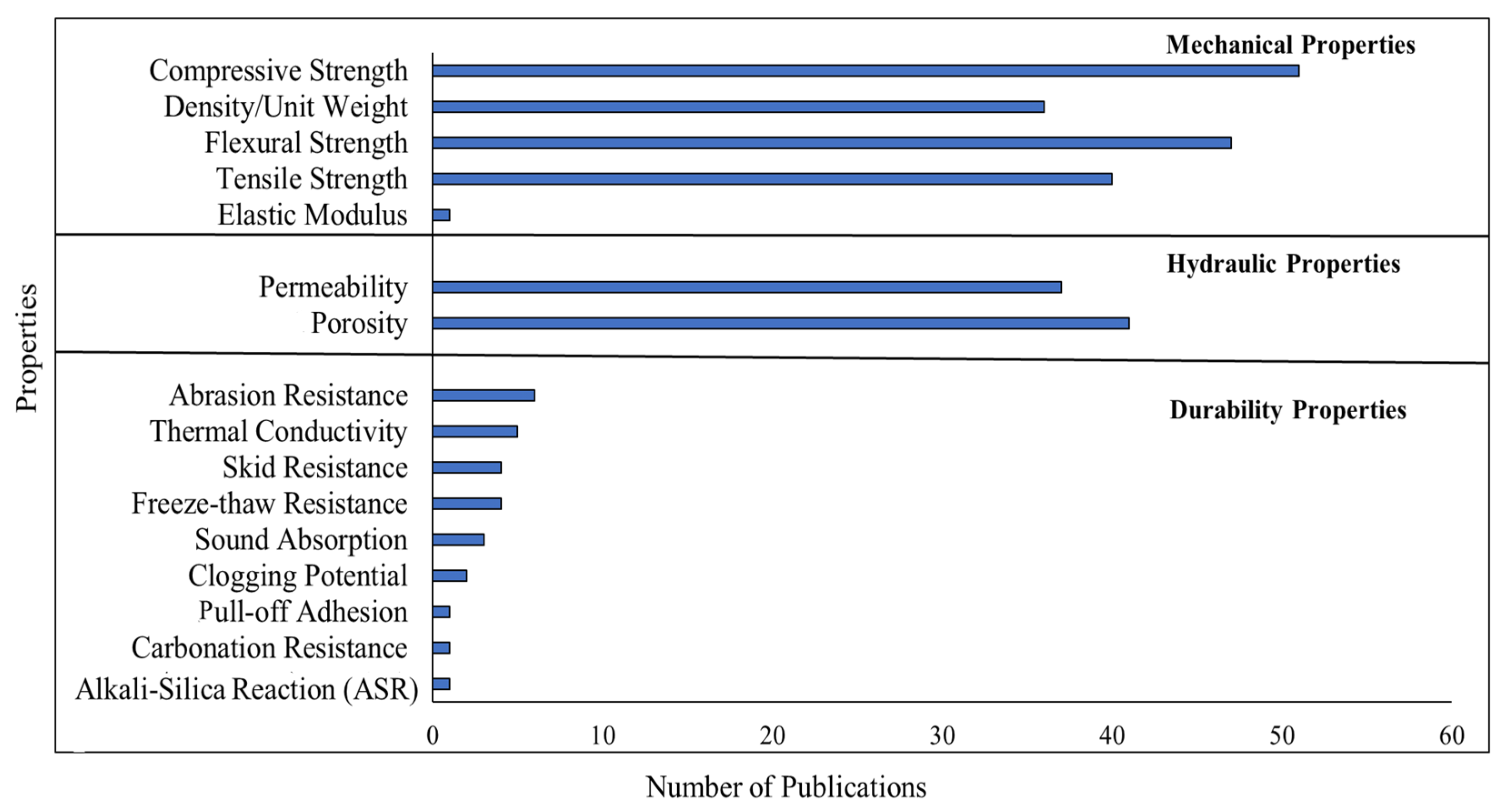
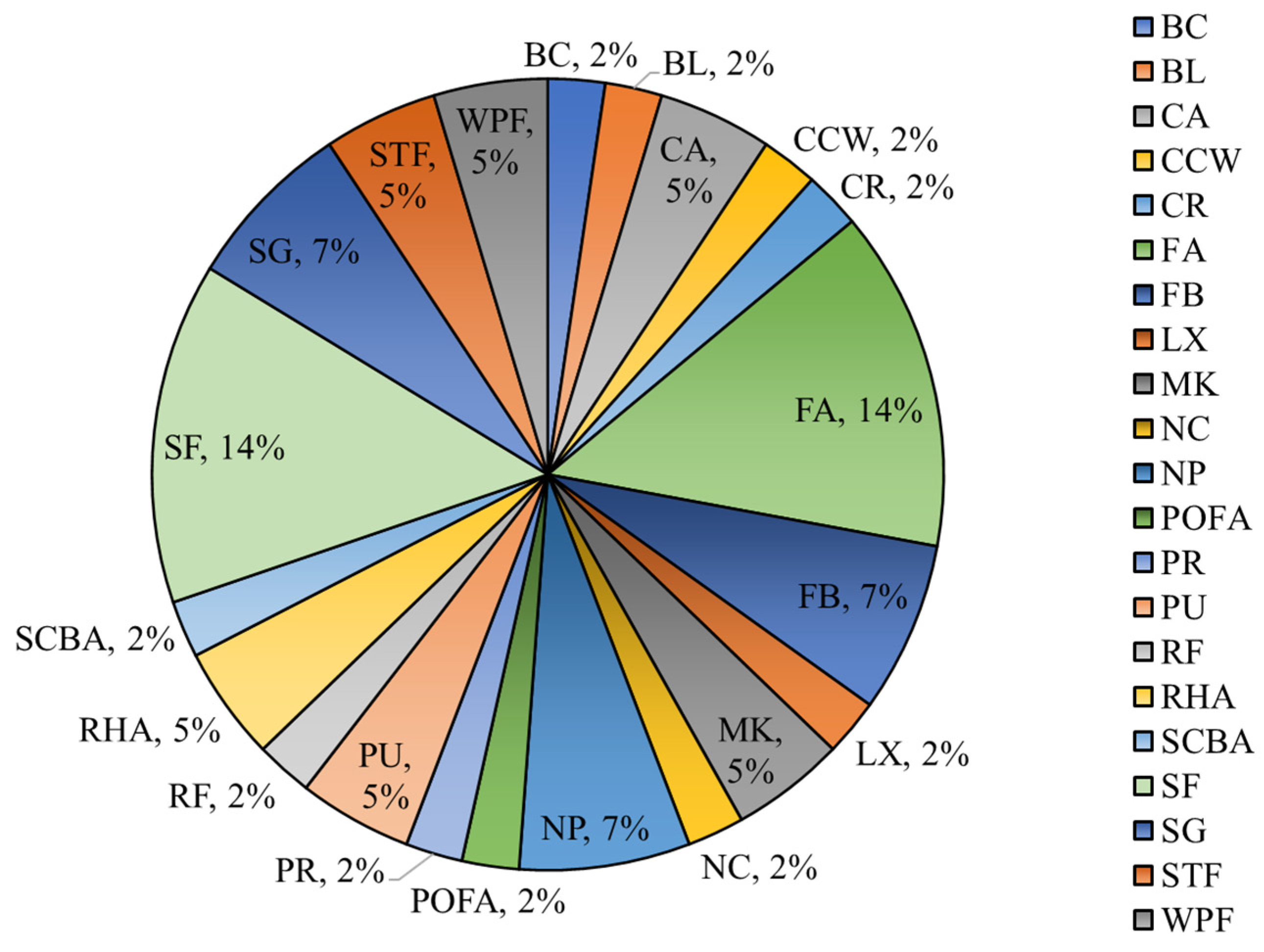
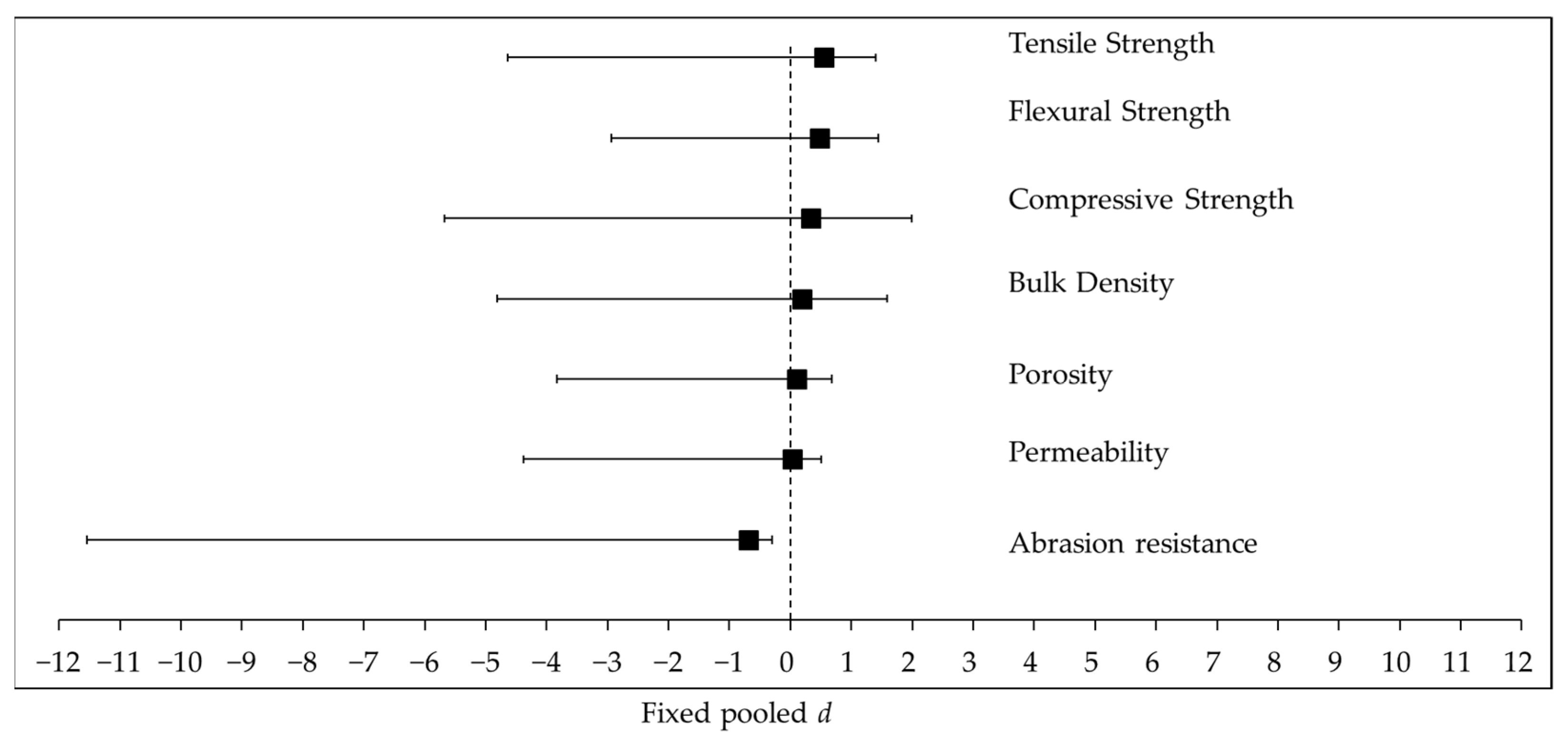
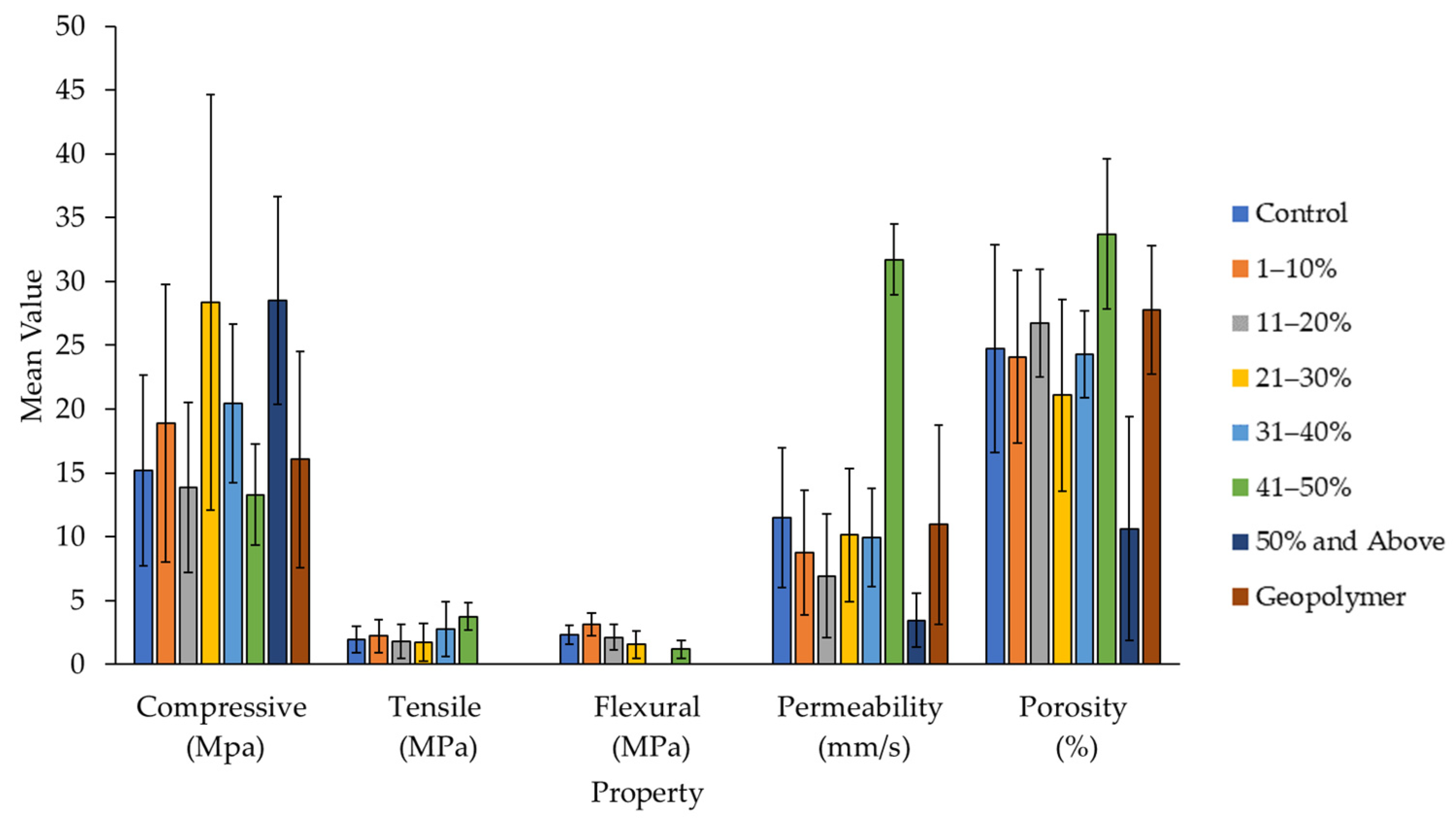
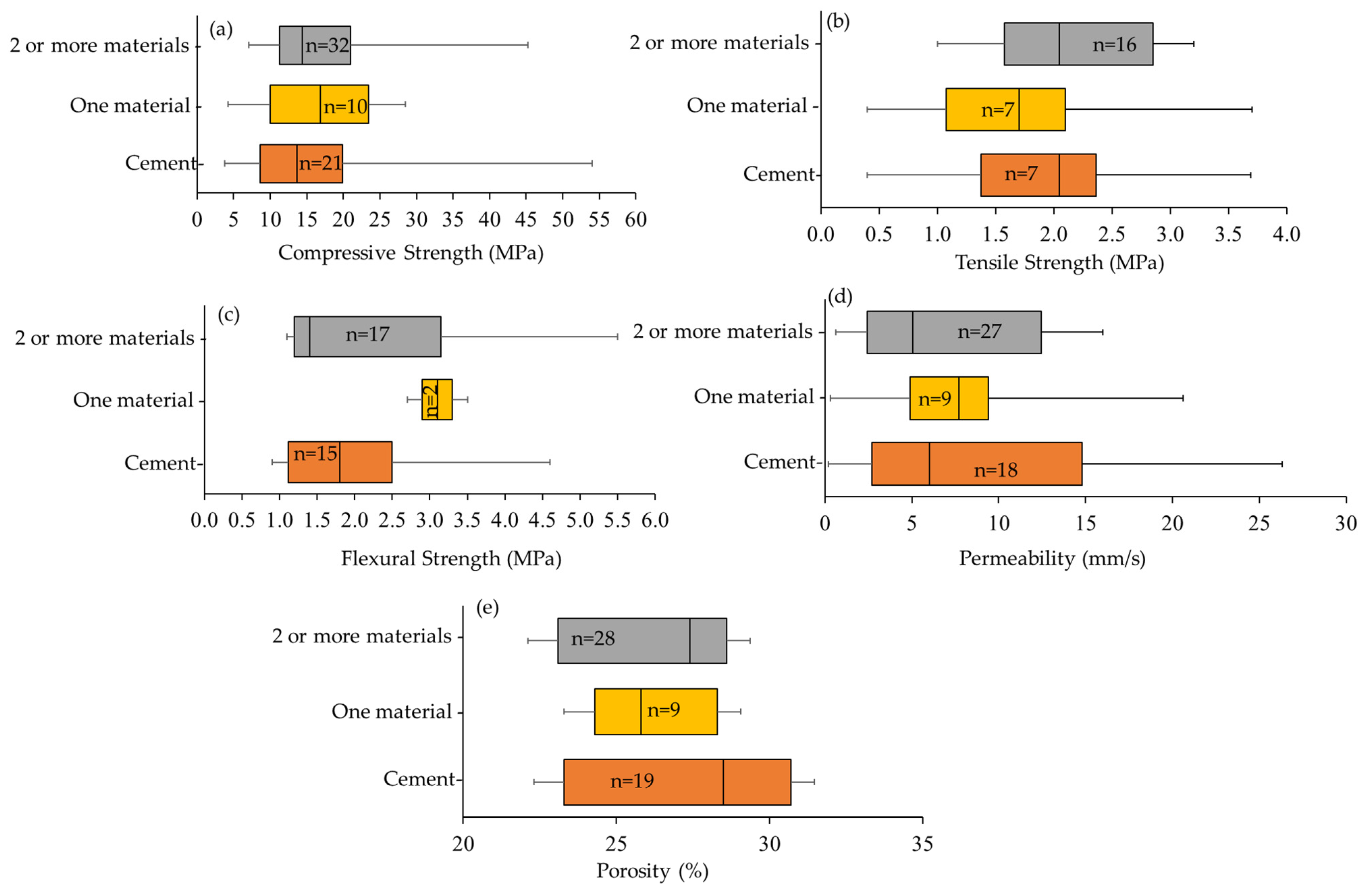

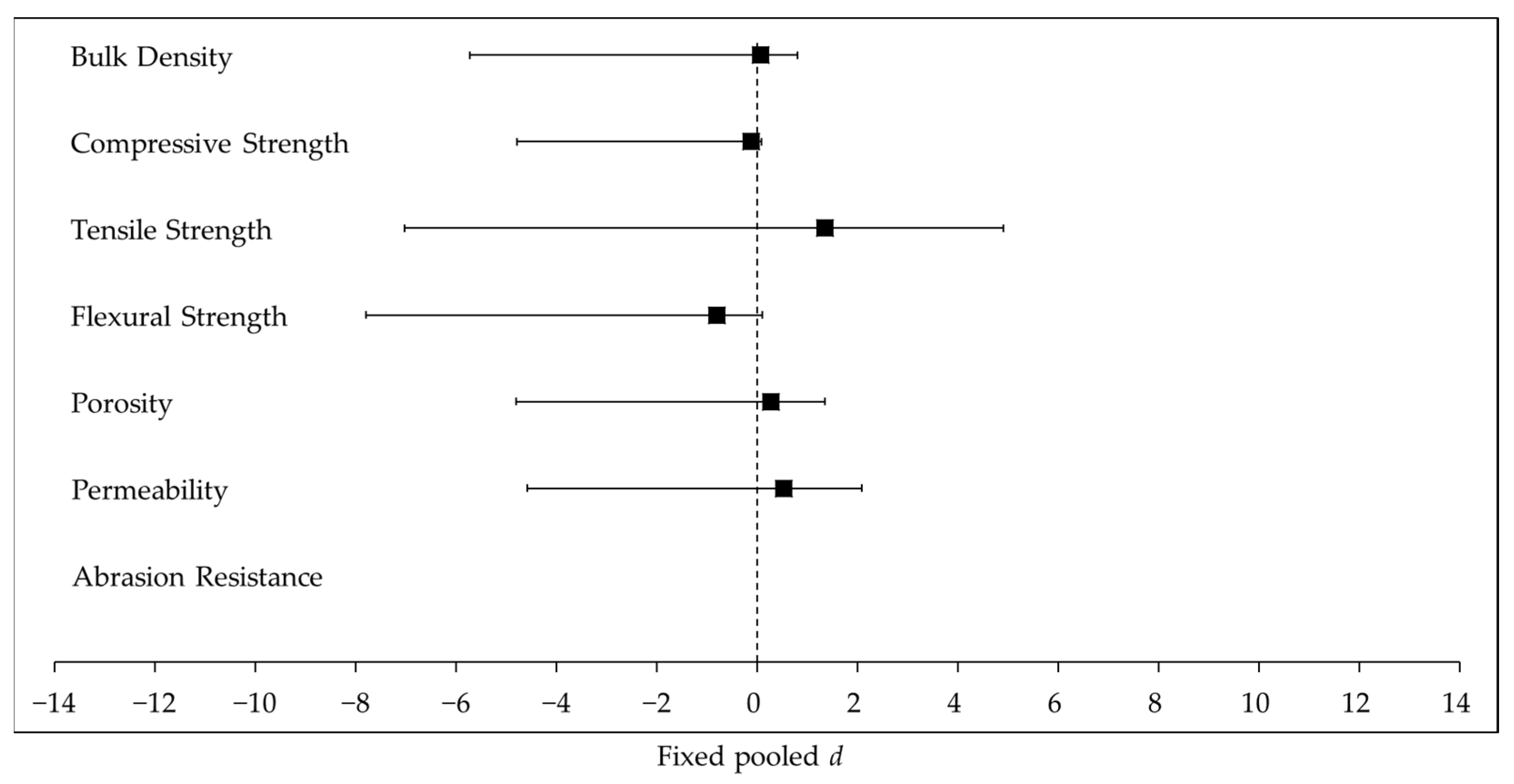
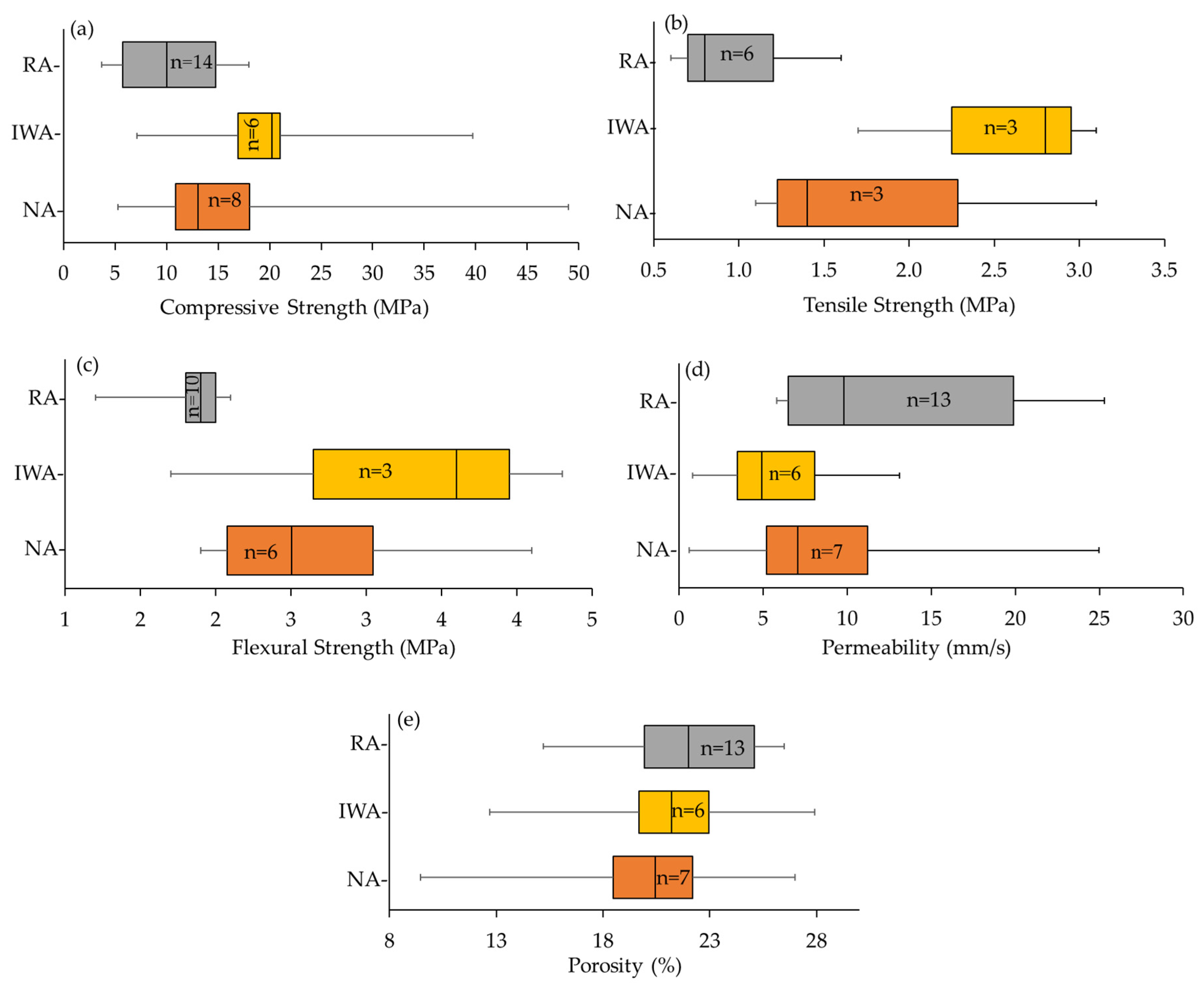
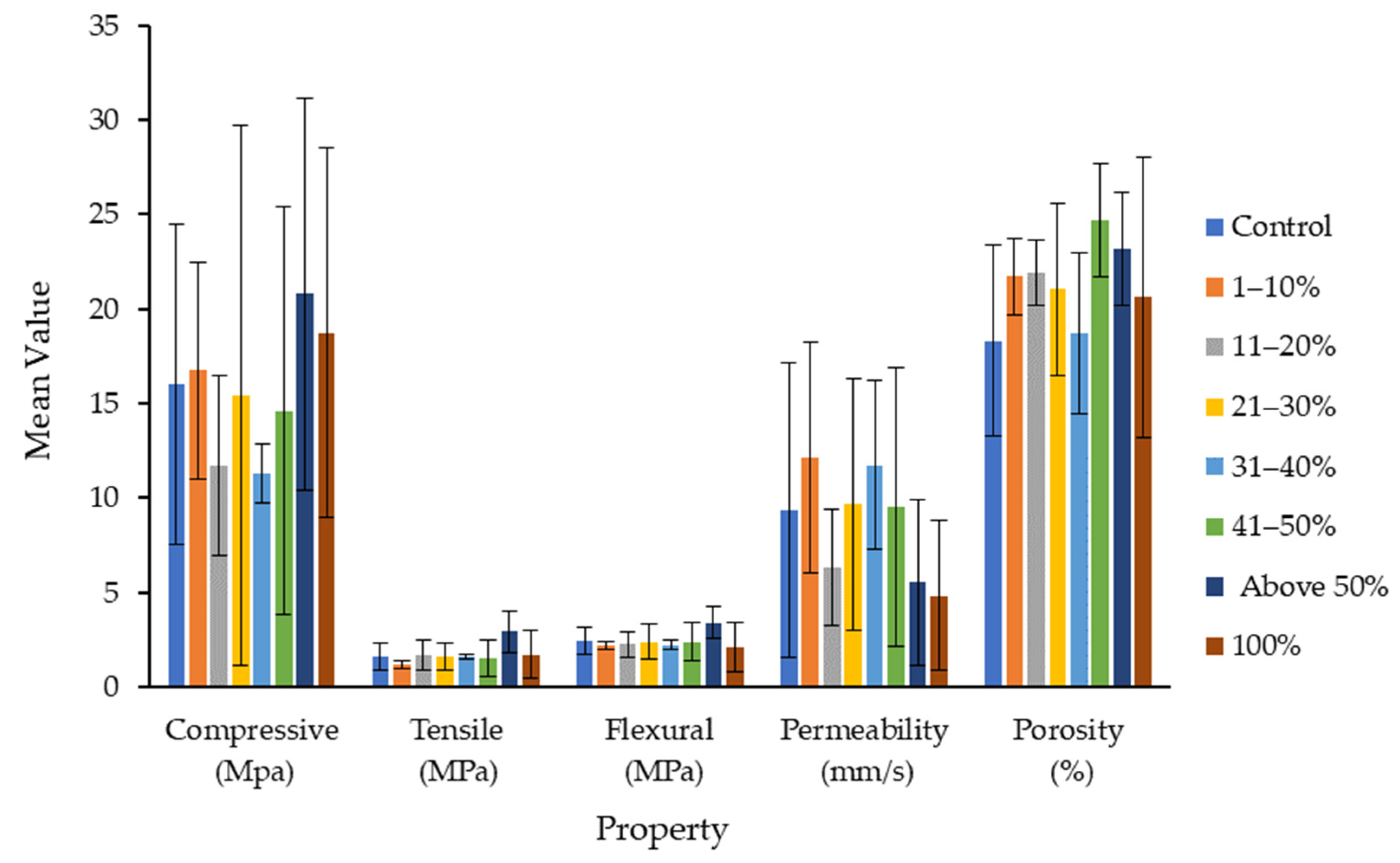

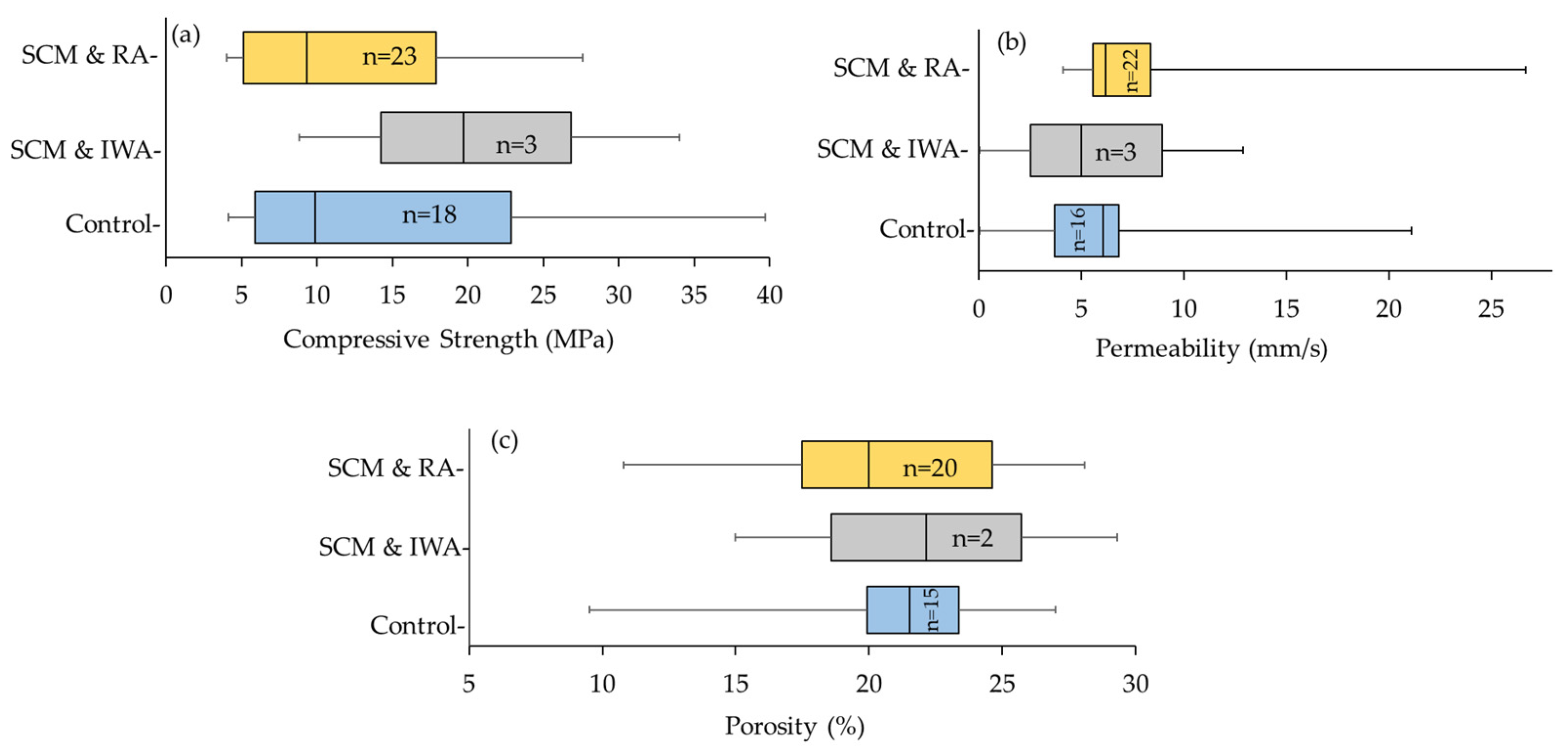
| Ref. | Type | Percentage Replacement | Mechanical Properties | Hydraulic Properties | Durability Properties | ||||
|---|---|---|---|---|---|---|---|---|---|
| Bulk Density | Compressive Strength | Tensile Strength | Flexural Strength | Porosity | Permeability | Abrasion Resistance | |||
| [4] | CA+RHA | 15% + 15% | * | −0.6 | - | - | 0.1 | −0.1 | - |
| [8] | POFA | 10, 20, 30, 40% | −1.3 | −1.8 | −1.8 | - | 1.7 | 1.8 | 1.5 |
| [9] | FA+SG | 15% + 25% | - | −1.1 | −14 | −19 | 12.8 | 2.5 | - |
| [10] | SF+NC (2% STF) | 10% + 1% | - | 14 | - | 4.9 | −8.2 | −3.7 | - |
| SF+NC | 10% + 2% | - | 25.2 | - | 23.1 | −8.1 | −10.5 | - | |
| SF+NC | 10% + 3% | - | 49.8 | - | 10.4 | −4.3 | −8.2 | - | |
| SF+NC (2%WPF) | 10% + 1% | 6.5 | 1.2 | 1.8 | 2.1 | −1.4 | −1.7 | - | |
| SF+NC | 10% + 2% | 4.9 | 2.0 | 1.5 | 2.3 | −1.7 | −1.2 | - | |
| SF+NC | 10% + 3% | 5.9 | 2.2 | 2.6 | 1.7 | −1.6 | −1.5 | - | |
| [17] | SF | 5, 10% | 3.0 | 4.4 | 1.5 | 2.3 | −3.5 | −3.5 | −9.0 |
| BL | 10, 20% | 6.0 | 1.9 | 1.0 | 1.2 | −6.7 | −2.6 | −21.0 | |
| RF | 1.5, 3% | −3.0 | −1.3 | −3.0 | −3.0 | 3.4 | 9.0 | - | |
| CR | 5, 10% | −3.0 | −2.5 | −4.3 | −3.4 | 2.0 | 5.0 | - | |
| [18] | SF | 5, 10, 15, 20, 25% | −1.6 | −1.6 | −0.9 | - | 1.8 | - | - |
| [20] | PR | 0.05, 0.1% | - | −1.1 | −1.7 | −1.1 | −2.1 | 1.0 | - |
| [21] | SF+MK+LX | 5% + 5% + 5% | - | 1.4 | 0.4 | 2.0 | - | −2.2 | - |
| [25] | RHA+CCW | 5, 10, 15% 20% | - | 0.0 | - | - | - | −0.8 | −0.6 |
| [27] | FA | 15% | 0.8 | 1.3 | - | - | −0.8 | - | - |
| FA+MK | 15% + 2% | 0.3 | 0.9 | - | - | 0.5 | - | - | |
| [28] | SG | 100% | - | −0.5 | - | - | 1.4 | 0.2 | - |
| SG+RM | 100% + 5% | 0.5 | 1.0 | 0.9 | 0.9 | −0.6 | 0.6 | −0.9 | |
| SG+RM | 100% + (5, 10) | 1.8 | 0.8 | 1.1 | 1.1 | −0.8 | −1.0 | −0.8 | |
| [31] | SG | 100% | - | −0.2 | - | - | 0.5 | 1.2 | - |
| [35] | PU + 2% STF | 10, 25, 50% | 1.5 | 0.4 | 0.3 | - | 2.8 | 5.7 | - |
| PU + 2% MF | 10, 25, 50% | 17.4 | 5.8 | 0.3 | - | 5.9 | 8.7 | - | |
| PU + 2% WPF | 10, 25, 50% | −1.4 | −0.5 | −2.1 | - | 2.8 | 4.2 | - | |
| PU | 10, 25, 50% | 0.2 | 0.5 | −0.1 | - | −0.4 | 24.8 | - | |
| PU+NC | 10% + 1, 2, 3% | 2.4 | −1.3 | 0.0 | - | 2.0 | 5.9 | - | |
| [36] | FA | 10, 20, 30, 40, 50% | - | 3.1 | 0.5 | - | - | - | - |
| [37] | FA | 20% | - | 0.3 | - | - | - | −1.3 | - |
| [39] | BC | 0.65, 3.2, 6.5, 9.5% 13.5% | - | 0.4 | 0.2 | - | −0.3 | −0.5 | - |
| [40] | SCBA | 5, 10, 15, 20, 25% | - | 0.5 | −0.1 | 1.8 | 0.8 | 0.7 | - |
| [41] | PM | 1 and 5% | - | −0.6 | 0.1 | - | −6.5 | - | - |
| [42] | FA (10 M) | 100% | −2.2 | 2.8 | 5.7 | - | 3.7 | −1.1 | −8.3 |
| FA (15 M) | 100% | 1.3 | 1.7 | 2.2 | - | −200 | 3.3 | −2.9 | |
| [43] | SG | 100% | −5.0 | 1.9 | - | - | 0.2 | 0.4 | - |
| Reference | Type | Percentage Replacement | Mechanical Properties | Hydraulic Properties | Durability | ||||
|---|---|---|---|---|---|---|---|---|---|
| Bulk Density | Compressive Strength | Tensile Strength | Flexural Strength | Porosity | Permeability | Abrasion Resistance | |||
| [17] | RA | 50% | −2.8 | −2.0 | −250.0 | −3.0 | 3.0 | 3.0 | −10.0 |
| 100% | −1.8 | −0.5 | 0.0 | −3.8 | 3.0 | 2.0 | −9.4 | ||
| [22] | RA | 25, 50, 75, 100% | −2.2 | −1.6 | - | −2.2 | 2.6 | 2.7 | - |
| [26] | SS | 25, 50, 75, 100% | 2.2 | 1.9 | 0.0 | 1.0 | 2.3 | 1.8 | - |
| [32] | RAP | 10, 20, 50, 100% | −1.3 | −2.3 | - | −1.7 | 1.0 | - | - |
| [35] | RA | 10, 25, 50, 100% | −1.6 | −1.3 | - | −2.7 | 1.6 | 2.3 | - |
| [44] | EAFS | 100% | 2.5 | 0.5 | - | - | 0.6 | 0.6 | - |
| [46] | PU | 10, 20, 30, 40, 50% | −2.4 | −1.4 | 1.4 | −1.0 | 0.9 | 0.8 | - |
| [57] | WG | 25, 50, 75, 100% | −1.9 | −1.8 | - | - | −1.3 | 1.9 | - |
| [58] | CS | 20, 40, 50, 60, 80, 100% | 2.6 | 1.9 | 2.5 | 4.4 | 4.4 | 1.3 | - |
| [59] | RA | 10% | - | 1.5 | 2.8 | - | −5.9 | −42.4 | - |
| [60] | RA | 25, 50, 75, 100% | - | −3.7 | - | −4.9 | - | 0.0 | - |
| [61] | RA | 100% | 2.9 | 0.3 | - | 0.3 | −0.6 | −0.6 | - |
| [62] | RA | 8% | - | 14.6 | - | - | −7.4 | −10.0 | - |
| Ref. | Cement Replacement (Percentage) | Aggregate Replacement (Percentage) | Mechanical | Hydraulic | Durability | ||||
|---|---|---|---|---|---|---|---|---|---|
| Density | Compressive Strength | Tensile Strength | Flexural Strength | Porosity | Permeability | Abrasion Resistance | |||
| [3] | SG (100%) | PN (5, 10, 15%) | - | −2.0 | −2.6 | - | - | - | - |
| SG (100%) | PN (3, 6, 12%) | - | 0.2 | 0.8 | - | - | - | - | |
| [4] | FA (10%) | SD (8%) | - | −0.3 | - | −0.1 | - | 0.0 | - |
| SF (5 and 10%) | RA (50%) | −5.0 | 50.0 | 3.3 | 10 | 3.0 | 1.9 | −3.9 | |
| CR (5 and 10%) | RA (50%) | −3.0 | 100 | 6.2 | 2.2 | 3.0 | 1.2 | −11 | |
| BL (10 and 20%) | RA (50%) | 11.0 | 2.9 | 2.0 | 10 | −7.0 | −1.5 | −3.4 | |
| [17] | RF (1.5 and 3%) | RA (50%) | 4.0 | 2.3 | 2.0 | 2.5 | −4.0 | −500 | −9.0 |
| SF (5 and 10%) | RA (100%) | 5.0 | 1.6 | 500 | 5.0 | −2.3 | −200 | −4.1 | |
| CR (5 and 10%) | RA (100%) | 5.0 | −1.3 | −1.9 | −2.7 | −3.0 | −3.0 | −27 | |
| BL (10 and 20%) | RA (100%) | 3.0 | −1.0 | 1.0 | −1.0 | −3.5 | −1.5 | −13.8 | |
| RF (1.5 and 3%) | RA (100%) | 4.0 | 5.0 | 2.0 | 3.3 | −3.0 | −5.0 | −3.2 | |
| [18] | SF (10%) | RA (25, 50, 75, 100%) | −0.8 | −1.3 | - | −1.7 | 2.1 | 2.5 | - |
| [35] | PU (10, 25, 50%) | RA (25, 50, 75, 100%) | −1.7 | −1.6 | - | −1.3 | 2.1 | 2.5 | - |
| PU (10%), NC (1, 2, 3%) | RA (25,50,75,100%) | −1.6 | −3.2 | - | −1.0 | 1.5 | 2.0 | - | |
| [44] | AAS (100%) | EAFS (100%) | −2.5 | 2.8 | - | - | 1.0 | 0.9 | - |
| [54] | SF (30%) | RA (25, 50, 75, 100%) | −2.1 | −1.7 | - | - | 2.1 | 1.5 | - |
| SF (30%) | WGC (25, 50, 75, 100%) | −1.8 | −2.8 | - | - | 1.6 | 2.7 | - | |
| [63] | GBFS (8%), FA (4%), SF (4%) | SS (100%) | −1.1 | −0.5 | - | - | 0.9 | 0.7 | - |
| [64] | FA (10%) | RA (25, 50, 75, 100%) | - | −4.7 | - | −4.5 | - | 0.8 | - |
Publisher’s Note: MDPI stays neutral with regard to jurisdictional claims in published maps and institutional affiliations. |
© 2022 by the authors. Licensee MDPI, Basel, Switzerland. This article is an open access article distributed under the terms and conditions of the Creative Commons Attribution (CC BY) license (https://creativecommons.org/licenses/by/4.0/).
Share and Cite
Anwar, F.H.; El-Hassan, H.; Hamouda, M.; Hinge, G.; Mo, K.H. Meta-Analysis of the Performance of Pervious Concrete with Cement and Aggregate Replacements. Buildings 2022, 12, 461. https://doi.org/10.3390/buildings12040461
Anwar FH, El-Hassan H, Hamouda M, Hinge G, Mo KH. Meta-Analysis of the Performance of Pervious Concrete with Cement and Aggregate Replacements. Buildings. 2022; 12(4):461. https://doi.org/10.3390/buildings12040461
Chicago/Turabian StyleAnwar, Faiz Habib, Hilal El-Hassan, Mohamed Hamouda, Gilbert Hinge, and Kim Hung Mo. 2022. "Meta-Analysis of the Performance of Pervious Concrete with Cement and Aggregate Replacements" Buildings 12, no. 4: 461. https://doi.org/10.3390/buildings12040461
APA StyleAnwar, F. H., El-Hassan, H., Hamouda, M., Hinge, G., & Mo, K. H. (2022). Meta-Analysis of the Performance of Pervious Concrete with Cement and Aggregate Replacements. Buildings, 12(4), 461. https://doi.org/10.3390/buildings12040461








